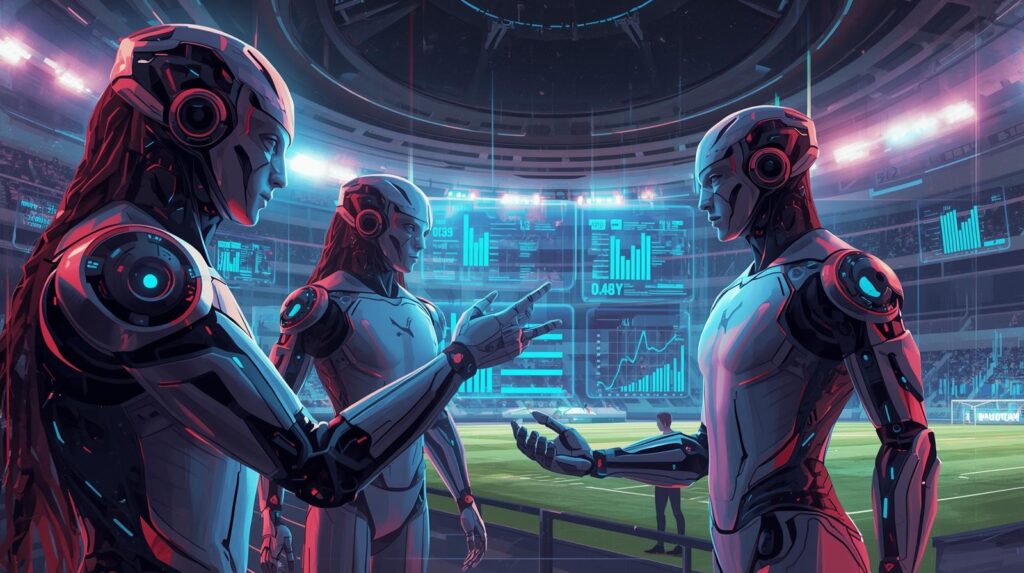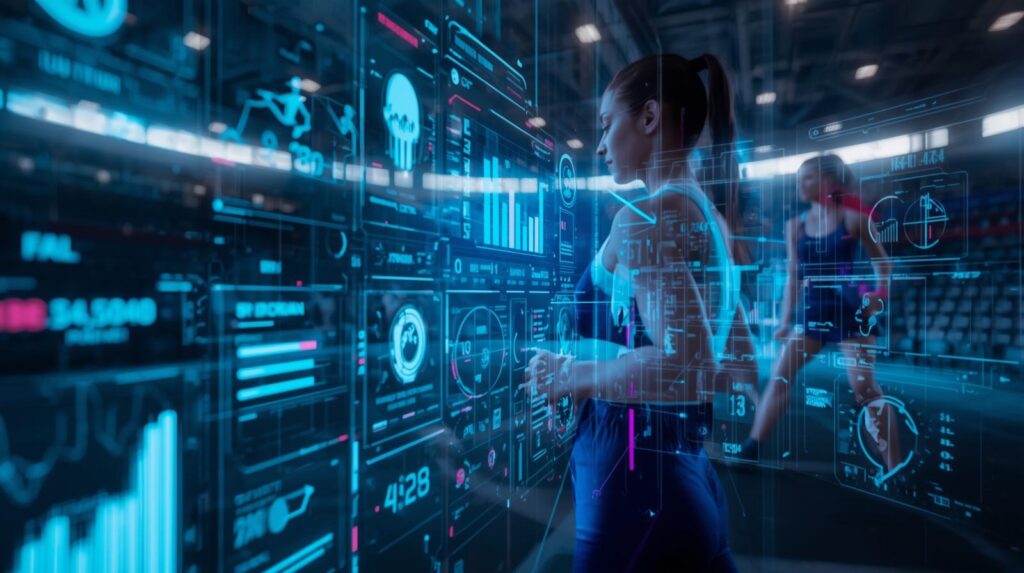The world of sports has always been a fusion of raw human talent and relentless pursuit of excellence. For decades, improvement was measured in fractions of a second, inches of distance, and the subjective eye of a coach. However, a new, powerful player has entered the arena, fundamentally altering how athletes train, compete, and recover. This game-changer is the integration of artificial intelligence in sports technology. No longer a futuristic concept, AI is now a core component of the modern sporting ecosystem, driving a data-driven revolution that is enhancing performance, mitigating injuries, and creating immersive experiences for fans worldwide. The application of artificial intelligence in sports technology is not just about replacing human intuition; it’s about augmenting it with unprecedented insights derived from vast, complex datasets.
The journey of technology in sports evolved from simple video replay to advanced wearable sensors that track heart rate and movement. While this generated a wealth of data, the real challenge was making sense of it all. This is where artificial intelligence in sports technology truly shines. AI and machine learning algorithms can process millions of data points—from player positioning and biomechanics to physiological responses and historical game footage—in seconds. This capability transforms raw data into actionable intelligence, providing coaches, athletes, and teams with a competitive edge that was previously unimaginable. The entire landscape of sports is being redefined by this powerful synergy.
The global Sports Technology Market was valued at USD 29.74 billion in 2024 and is projected to grow from USD 34.25 billion in 2025 to USD 68.70 billion by 2030, at a CAGR of 14.9% during the forecast period.

The Core of Performance: AI-Driven Training and Analytics
The most significant impact of artificial intelligence in sports technology is observed in athlete training and performance analytics. Traditional methods relied on periodic testing and coach observation. Today, AI enables continuous, real-time analysis.
Biomechanical Analysis and Movement Optimization
High-speed cameras and sensors capture an athlete’s every move, generating intricate data on their technique. AI algorithms analyze this data to identify subtle inefficiencies or biomechanical flaws that the human eye could never detect. For instance, in sports like baseball or cricket, AI systems can break down a pitcher’s or bowler’s action frame-by-frame, assessing torque on the elbow, hip/shoulder separation, and release point to optimize performance while reducing injury risk. Similarly, swimmers can use AI feedback to refine their stroke technique for minimal drag and maximum propulsion.
Personalized Training Regimens
AI-powered platforms can create hyper-personalized training programs for each athlete. By analyzing data from wearables, performance history, sleep patterns, and nutrition, the AI can adjust daily workout intensity, volume, and type. It can predict an athlete’s readiness to train, recommend specific drills to target weaknesses, and even suggest optimal recovery protocols. This move from a one-size-fits-all approach to a uniquely tailored strategy maximizes training efficiency and accelerates athletic development, pushing the boundaries of human potential.
A Proactive Shield: Injury Prediction and Prevention
Injuries are the bane of any athlete’s career. The integration of artificial intelligence in sports technology is shifting the medical paradigm from reactive treatment to proactive prevention. By analyzing patterns in training load, movement asymmetry, and physiological markers, AI models can identify athletes who are at a heightened risk of suffering a specific injury.
These predictive analytics allow sports medicine staff to intervene before an injury occurs. The AI system might flag that a soccer player is exhibiting running gait asymmetries linked to hamstring strains or that a basketball player’s landing mechanics have changed, increasing ACL tear risk. With this early warning, trainers can prescribe prehab exercises, adjust training load, or recommend more rest. This not only protects multi-million dollar investments for teams but, more importantly, safeguards the health and longevity of the athletes themselves, ensuring they can perform at their peak for longer.
The Digital Coach: Strategic Game Planning and Opponent Analysis
Beyond physical training, artificial intelligence in sports technology is a master strategist. Coaches now use AI-driven video analysis software to dissect both their own team’s performances and those of their opponents. These systems can automatically tag and categorize every single event in a game—passes, shots, tackles, turnovers, and player movements—creating a searchable database of actions.
This allows coaches to move beyond gut feeling and identify definitive tactical patterns. An AI can reveal that a rival basketball team consistently turns the ball over when faced with a specific defensive press or that a soccer team is most vulnerable to attacks down their left flank. During games, AI-powered tools provide real-time tactical suggestions, offering insights based on live data that can be the difference between a win and a loss. This depth of strategic analysis, powered by artificial intelligence in sports technology, is like having an entire team of analysts working around the clock.
Beyond the Field: Enhancing the Fan Experience and Broadcasting
The influence of artificial intelligence in sports technology extends far beyond the athletes and directly to the millions of fans who watch them. AI is personalizing and enriching how we consume sports. Streaming services use AI to offer personalized highlight reels curated for individual users based on their favorite teams and players. Broadcasts are enhanced with AI-generated graphics and real-time statistics overlays that provide deeper context to the action.
- Virtual and Augmented Reality: AI is key to creating immersive VR and AR experiences, allowing fans to feel like they are sitting courtside or even on the team’s bench.
- Interactive Platforms: chatbots and AI-driven apps provide fans with instant answers to statistics, trivia, and player information, creating a more engaging and interactive experience.
Furthermore, teams and venues use AI for operational efficiency. Smart stadiums employ AI for security monitoring, crowd management, and optimizing concession stand wait times, ensuring a smoother and safer experience for everyone in attendance.

The Ethical Considerations and Future Horizon
As with any transformative technology, the rise of artificial intelligence in sports technology brings forth important ethical questions. Issues of data privacy, the potential for a “technological arms race” favoring wealthy teams, and the fear of over-reliance on data at the expense of human intuition and the spirit of the game are all valid concerns. Governing bodies are now tasked with creating frameworks to ensure this powerful tool is used fairly and responsibly.
Looking ahead, the future of artificial intelligence in sports technology is incredibly exciting. We are moving towards even more sophisticated applications like AI-designed equipment optimized for individual athletes, the use of computer vision for fully automated officiating to eliminate human error, and advanced neural networks that could potentially devise entirely new game strategies. The fusion of human athleticism and artificial intelligence is creating a new golden age of sports, where the limits of performance are constantly being redefined.
The integration of artificial intelligence in sports technology is a monumental shift, not a passing trend. It has permeated every facet of the industry, from the way an athlete prepares their body to the way a fan in another continent experiences the thrill of the game. By turning data into wisdom, AI is empowering athletes to reach new heights, protecting their well-being, and providing coaches with unparalleled strategic insights. While mindful of the ethical landscape, the sporting world must embrace this revolution. The future of sports is intelligent, data-driven, and incredibly promising, all thanks to the powerful synergy between human potential and artificial intelligence.
Explore In-Depth Semiconductor & Electronics Market Research
https://www.marketsandmarkets.com/semiconductorand-electonics-market-research-87.html
FAQs
1. How does artificial intelligence in sports technology improve an athlete’s performance?
AI uses data from wearables and cameras to analyze biomechanics, identify inefficiencies in technique, and create personalized training regimens. It provides actionable feedback to optimize movement, strength, and conditioning, leading to measurable performance gains.
2. Can AI really help prevent sports injuries?
Yes, a primary application of AI is injury prevention. By analyzing data on training load, movement patterns, and physiological markers, AI algorithms can identify athletes who are exhibiting risk factors for specific injuries, allowing medical staff to intervene with targeted prehabilitation before an injury occurs.
3. Are there any downsides or risks to using AI in sports?
Potential downsides include ethical concerns over data privacy for athletes, the high cost of technology potentially creating a competitive imbalance between rich and poor teams, and an over-reliance on data that might undermine a coach’s intuition and the inherent human element of sports.
4. How is AI changing the experience for sports fans?
AI is revolutionizing fan engagement by powering personalized highlight reels, generating real-time statistics and graphics during broadcasts, enabling immersive VR experiences, and facilitating interactive apps and chatbots that provide instant access to information and content.
5. Will AI eventually replace coaches and scouts?
No, AI is not a replacement but a powerful tool that augments human expertise. Coaches and scouts will continue to provide leadership, motivation, and emotional intelligence. AI empowers them with deeper insights and data-driven evidence to make more informed decisions about strategy, player development, and recruitment.
See The Latest Semiconductor Reports:
Oil Condition Monitoring Market Size, Share & Trends : https://www.marketsandmarkets.com/Market-Reports/oil-condition-monitoring-market-62105661.html
Agriculture IoT Market Size, Share & Trends : https://www.marketsandmarkets.com/Market-Reports/iot-in-agriculture-market-199564903.html
Real-time Location Systems (RTLS) Market Size, Share & Trends : https://www.marketsandmarkets.com/Market-Reports/real-time-location-systems-market-1322.html
LiDAR Market Size, Share & Trends: https://www.marketsandmarkets.com/Market-Reports/lidar-market-1261.html
HVDC Transmission Market Size, Share & Trends: https://www.marketsandmarkets.com/Market-Reports/hvdc-grid-market-1225.html